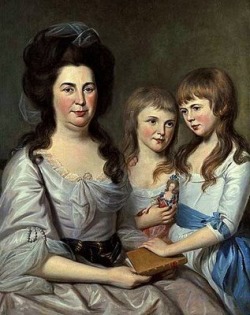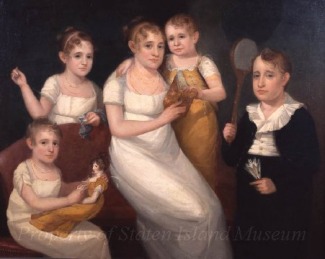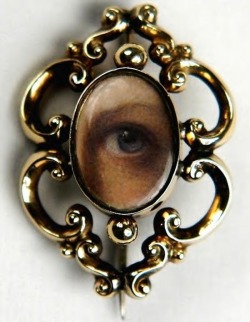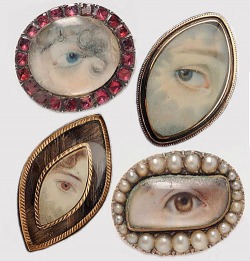The latest article I read discusses many British and American portraits that depict women and young girls with reference to their dress and dolls. (I won't write much about the dolls, but maybe in a later post). The author asks why the children look so solemn and serious. They are not at all child-like and carefree as we know most children to be in our modern day. There is a rising number of paintings depicting children after 1750. The consistent theme of these portraits seems to be the representation of the ideal woman; a picture of modesty, obedience, submissiveness, and chastity. The portrait most thoroughly discussed is by Charles William Peale Mrs. Robert Gilmore and Her Daughters. The mother looks straight ahead while the younger daughter looks out to the left and the other daughter looks out into the “middle distance.” They are wearing different types of dress. The daughters wear real dresses from this time, while the mother is wearing a dress that is an invention of the artist. The doll held by the younger girl shows the high fashions of the high eighteenth century. The children wear white, unembellished dresses common for children. Before the mid-eighteenth century children went straight from infant clothing to smaller versions of adult clothing. The frock we see here is simpler than the gown, petticoat, and stomacher ensemble that children of earlier times were expected to wear. According to portraiture they are usually white which represents the innocence of childhood. The artist invents a dress for Mrs. Gilmore, as is common at this time for women of a certain age, in a way to "virtuously avoid fashion". Women’s fashion and hairstyles are highly criticized by men at this time. The doll represents the education of women (because they were used to learn sewing and other skills), but also the dangers of high fashion and the childish emphasis on appearance. The girl that holds the doll looks away from her mother and the moral lesson of the book while the other girl meditates on the story’s merits as she places her hand on her mother's book. As a woman having her portrait painted she must be able to accept an artist’s alternative image of herself. It is important to realize that the artist, a man, and the patron, her husband are the ones who create this image of the woman and her daughters. This is a time when a woman's choice of dress is one of her few freedoms. Hoop skirts are even seen by some at the time as a declaration of a woman’s personal space. Men, however, see these and other fashions as evidence of sexual promiscuity or in some instances a desire to appear more masculine. The indifference of the women is evident by the repeated reminders by the men. This most likely causes much fear in the men as they realize that women might actually dress to please themselves. (gasp!) The author then explains a drastic change in dress that occurs right around 1800. The dress consisting of multiple parts that had been used for centuries is replaced by a simpler “all-in-one” dress similar to the frocks of children. The appropriate age to wear the children’s frocks continues to rise until adult women begin wearing them. The entire structure of the eighteenth-century silhouette changes. (Think about something like Marie Antoinette vs. Jane Austen dresses.) If the hoop skirt and other fashions do represent freedom and person space, this development in fashion reveals a great loss in this space. The author believes that this style of dress, now synonymous with purity and innocence of youth, becomes a trend at least partly due to the portraits she discusses and the artists invented fashions (or "non-fashions"). The author states that many things (rationality, aesthetics, politics, etc.) must have come together for such a drastic change. She concludes that whatever is responsible, the consensus is for a visual simplicity and innocence in women. In conclusion, she states that these portraits of women and their daughters are most often painted to show the perfect ideal of how a woman should behave and who daughters should emulate.
My title is just a joke. I do not want to wear a hoop skirt at all. This article does, however, make me curious about so many things. Firstly, I want to know why these women finally went along with the style men seem to be pushing..... a look of childlike innocence. I hope it had something to do with comfort. Perhaps I will research this more because such a sudden shift in fashion seem quite strange. It also amazes me that these outfits that we view as ridiculous, cumbersome, and uncomfortable, might have been seen as a mark of freedom for the women??? For a long time I have wrongly assumed that men must have wished their women to look in certain exaggerated ways (hourglass figures, padded hips, etc.) when really, according to all the writings and criticism, they seem to prefer the more natural. There is even much talk at this time about their desire to see hair down flowing naturally around the neck instead of up in these complicated arrangements of wigs and powders and attachments. I can not even attempt to address the amount of criticism of make-up during the eighteenth century because there is so much literature on that one subject. I do get the impression that men still prefer that more natural look since they are always saying they prefer no make-up etc. Hmm... if that is true then I guess their tastes have not changed much in the last few hundred years? (probably longer) ;)
My title is just a joke. I do not want to wear a hoop skirt at all. This article does, however, make me curious about so many things. Firstly, I want to know why these women finally went along with the style men seem to be pushing..... a look of childlike innocence. I hope it had something to do with comfort. Perhaps I will research this more because such a sudden shift in fashion seem quite strange. It also amazes me that these outfits that we view as ridiculous, cumbersome, and uncomfortable, might have been seen as a mark of freedom for the women??? For a long time I have wrongly assumed that men must have wished their women to look in certain exaggerated ways (hourglass figures, padded hips, etc.) when really, according to all the writings and criticism, they seem to prefer the more natural. There is even much talk at this time about their desire to see hair down flowing naturally around the neck instead of up in these complicated arrangements of wigs and powders and attachments. I can not even attempt to address the amount of criticism of make-up during the eighteenth century because there is so much literature on that one subject. I do get the impression that men still prefer that more natural look since they are always saying they prefer no make-up etc. Hmm... if that is true then I guess their tastes have not changed much in the last few hundred years? (probably longer) ;)




 RSS Feed
RSS Feed
